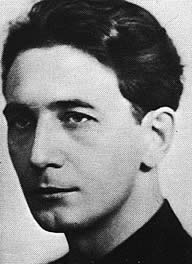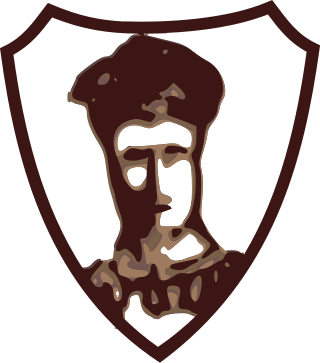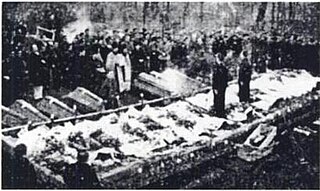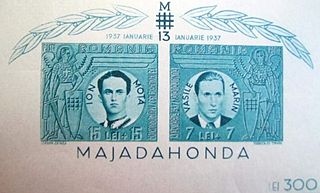
The Iron Guard was a Romanian militant revolutionary fascist movement and political party founded in 1927 by Corneliu Zelea Codreanu as the Legion of the Archangel Michael or the Legionary Movement. It was strongly anti-democratic, anti-capitalist, anti-communist, and anti-Semitic. It differed from other European right-wing movements of the period due to its spiritual basis, as the Iron Guard was deeply imbued with Romanian Orthodox Christian mysticism.

Corneliu Zelea Codreanu, born Corneliu Zelinski and commonly known as Corneliu Codreanu, was a Romanian politician of the far right, the founder and charismatic leader of the Iron Guard or The Legion of the Archangel Michael, an ultranationalist and violently antisemitic organization active throughout most of the interwar period. Generally seen as the main variety of local fascism, and noted for its mystical and Romanian Orthodox-inspired revolutionary message, it gained prominence on the Romanian political stage, coming into conflict with the political establishment and the democratic forces, and often resorting to terrorism. The Legionnaires traditionally referred to Codreanu as Căpitanul, and he held absolute authority over the organization until his death.

Armand Călinescu was a Romanian economist and politician, who served as 39th Prime Minister from March 1939 until his assassination six months later. He was a staunch opponent of the fascist Iron Guard and may have been the real power behind the throne during the dictatorship of King Carol II. He survived several assassination attempts but was finally killed by members of the Iron Guard with German assistance.

Horia Sima was a Romanian fascist politician, best known as the second and last leader of the fascist paramilitary movement known as the Iron Guard. Sima was also the vice president of the council of ministers and de facto co-leader in Ion Antonescu's National Legionary State. Sima had previously served briefly as State Secretary of Education under Gheorghe Tătărescu in 1940, and as a short-lived Minister of Religion and Arts in the government of Ion Gigurtu.

Mihai Stelescu was a Romanian political activist.

The National Legionary State was a totalitarian fascist regime which governed Romania for five months, from 14 September 1940 until its official dissolution on 14 February 1941. The regime was led by General Ion Antonescu in partnership with the Iron Guard, the Romanian ultra-nationalist, anti-Semitic, and anti-communist organization. Though the Iron Guard had been in the Romanian Government since 28 June 1940, on 14 September it achieved dominance, leading to the proclamation of the National Legionary State.

The Crusade of Romanianism was an eclectic revolutionary movement in Romania. Founded in late 1934 by Mihai Stelescu, it originated as a dissident faction of the Iron Guard, Romania's main fascist movement, and was virulently critical of Guard leader Corneliu Zelea Codreanu. Stelescu, who had served as one of the Guard's orators and paramilitary organizers, reinterpreted nationalist ideology through the lens of anticapitalism and "humane" antisemitism; also appropriating some ideas from communism and classical (Italian) fascism, his followers were sometimes described as Romania's Strasserists. The Crusade was briefly but centrally associated with Panait Istrati, world-renowned novelist and dissident communist, who, before his death in early 1935, added into the mix of "Romanianism" some elements of libertarian socialism. Stelists offered an alternative paramilitary symbolism to that of Codrenists, which included a cult of personality surrounding Stelescu and Istrati, as well as a uniform of deep-red (carmine) shirts—opposed to the green shirts used by the Guardists, which had also been introduced by Stelescu during his time there. In geopolitical terms, they were either fearful of, or openly hostile toward, Nazism.

Corpul Muncitoresc Legionar or Corpul Muncitorilor Legionari was a fascist association of workers in Romania, created inside the Iron Guard and having a rigid hierarchical structure. From its creation until September 1940, the CML was led by Gheorghe Clime; afterwards, the position was filled by Dumitru Groza, who oversaw the Corps during the period when the Iron Guard was in power — the National Legionary State —, and involved it in the 1941 Rebellion and Pogrom. The CML had its headquarters in Bucharest, on Calea Călăraşilor.

During the 1930s, three notable death squads emerged from Romania's Iron Guard: the Nicadori, the Decemviri and the Răzbunători. Motivated by a combination of fascist political ideology and religious-nationalist mysticism, they carried out several high-level political assassinations in the inter-war period.
Irina Livezeanu is a Romanian-American historian. Her research interests include Eastern Europe, Eastern European Jewry, the Holocaust in Eastern Europe, and modern nationalism. Several of her publications deal with the history of Romania, Moldova, and Bessarabia. Since 1996, she is associate professor, Department of History, University of Pittsburgh. In 2010–2013 she served as president of the Society for Romanian Studies.

The Funerals of Ion Moța and Vasile Marin were a series of wide-scale demonstrations in Romania. The two leaders of the Iron Guard had been killed in battle on the same day, January 13, 1937, at Majadahonda while fighting on the side of Francoist Spain during the Spanish Civil War, and the funeral that followed took the form of a highly-organized, cross-country procession.

The relationship between the Romanian Orthodox Church and the Iron Guard was one of ambivalence. The Romanian Orthodox Church promoted its own version of nationalism which highlighted the role of Orthodoxy in preserving the Romanian identity. Starting with the 1920s, the Church became entangled with fascist politics and antisemitism. In this context, the Iron Guard, also known as the Legion of the Archangel Michael, a fascist movement founded in 1927, became very influential with church grassroots. Numerous rank-and-file priests joined the Iron Guard ranks and actively supported its policies; so did a minority of influential high-ranking clergymen such as Nicolae Bălan or Vartolomeu Stănescu.
Vasile Noveanu (1904–1992) was a Romanian activist of the Iron Guard.

Prince Alexandru Cantacuzino was a Romanian lawyer and politician, a leading member of the Legionary Movement, and a close collaborator of Legionary leader Corneliu Zelea Codreanu. He notably devised a plot to overthrow Carol II, King of Romania, a plan that would later be taken over by Legionary leader and later Vice President of the Council of Ministers Horia Sima. Cantacuzino was killed on September 22, 1939, at the prison in Râmnicu Sărat, during a retaliation operation ordered by Carol II following the assassination of Prime Minister Armand Călinescu.

Gheorghe Cantacuzino-Grănicerul was a Romanian landowner, general, and far-right politician who was a member of the Iron Guard, and a member of the Legionary Senate.

Ilie Gârneață was a lawyer and founding member of the Legionary Movement, a far-right movement in Romania.

Neo-Legionarism is a neo-fascist movement in Romania that emerged in the 1990s following the fall of communism in the country. It is endorsed by a series of organizations that claim to be the sucessors of the Iron Guard founded by Corneliu Zelea Codreanu in 1927. Its main characteristics include antisemitism, Eastern Orthodoxy, ethnic nationalism and mysticism.

Gheorghe Clime was a Romanian fascist politician, leading member of the Iron Guard, and president of its electoral wing, Totul pentru Țară.

Radu Mironovici was a founding member of the Legionary Movement, a far-right movement in Romania.

Buna Vestire was a far-right Romanian newspaper affiliated with, and later published by, the Iron Guard.














